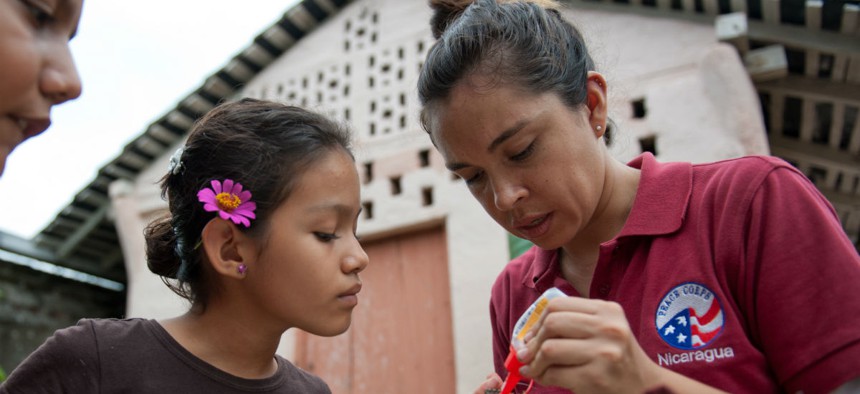
Field officials and volunteers throughout the world are not subject to the cuts. Flickr user Peace Corps
Peace Corps to Cut 20 Percent of Its Workforce
Trump requirements to slash jobs led to 'challenging' changes and 'difficult decisions,' acting director says.
The Peace Corps is eliminating more than 20 percent of its workforce, the agency announced to employees earlier this month, in an effort to meet the demands in an executive order from President Trump.
The agency is not planning at this point to lay off any of its employees, according to internal documents obtained by Government Executive, though it has not ruled out the possibility. Peace Corps employees working domestically serve on five-year term limits and must depart the agency at the expiration of that period. It is now “sunsetting” about 200 of its roughly 900 stateside workers, meaning when those employees hit their “not to exceed” dates they will depart the agency and their positions will not be filled. If the employees leave the agency or are reassigned before that date, their positions will be sunset at that point.
Peace Corps began its “rightsizing” initiative on Aug. 7; field officials and volunteers throughout the world are not subject to the cuts. A spokesperson said the reductions will take three years to complete.
In an email to all Peace Corps employees, acting Director Sheila Crowley made clear the decision came as a result of “external directives” and acknowledged it could lead to some difficulties for agency employees.
“We understand that this will be challenging and I deeply appreciate your understanding and flexibility as we work through these difficult decisions and develop processes to ensure effective operations,” Crowley wrote.
Each Peace Corps office has already identified which positions it will sunset by "finding efficiencies in their operations while maintaining quality support to our volunteers,” Crowley said. While the agency said it does not anticipate any reductions in force, typically employees are eligible for an extra “tour” of 2.5 years after they hit their five-year mark. Workers in sunsetting positions will no longer be eligible for such an extension. The agency also said it will ramp up the pressure for those employees to find a new job.
“In order to achieve the workforce reduction and cost savings needed to align with the FY18 budget, the agency will encourage employees in sunset positions to move into non-sunset Peace Corps positions or seek jobs outside the agency,” the agency wrote in guidance to employees. At another point in the document, the agency said it would “strongly encourage” those employees to find other opportunities. It added they may end up laying off workers if it faces future budgetary pressures or other external directives. One Peace Corps employee told Government Executive that neither the head of her office nor the human resources representative could guarantee she could stay until reaching her five-year mark.
The agency cited its fiscal 2018 budget request of $398 million, a 3 percent reduction, as partly driving the need to make cuts. The House Appropriations Committee met that request in a bill it approved in July. The Peace Corps also cited a provision of the Office of Management and Budget guidance on Trump’s order that called for agencies to take “immediate actions to achieve near-term workforce reductions” in justifying the cuts.
The agency said it will do its best to keep employees apprised of vacancies as they arise, but will not offer those in sunsetting positions any priority when applying. In some cases, Peace Corps may reassign employees to vacant positions in the same grade if there is a “legitimate organizational reason” to do so. The agency may fire any employee who declines to accept such a reassignment. Peace Corps said it will make resources available to help employees put out of a job, such as “federal resume writing workshops, cross-training opportunities, career development and counseling sessions, webinars and other activities.”
"Peace Corps is a dynamic and agile organization committed to continually improving operations and providing quality support to volunteers," the agency spokesperson said. "This plan is a part of Peace Corps’ broader strategic assessment of the agency’s operational needs, which focuses on enabling each volunteer to have a healthy and productive service.”
Glenn Blumhorst, president and CEO of the National Peace Corps Association, said he was aware Peace Corps was “undertaking some exercises to be as cost effective and efficient as possible.” He has been told by agency leadership the workforce cuts would not impact the number of volunteers it deploys, but Blumhorst still called for Congress to maintain the agency’s fiscal 2017 appropriation of $410 million.
Crowley said the agency approached the job reductions with a “deep respect” for the agency’s “institutional culture,” and for its employees. She intimated the cuts were necessary for the survival of the agency.
“We remain steadfast in our commitment to a strong, resilient Peace corps,” Crowley said. “We are pursuing an approach to these external directives that honors our 56-year legacy and ensures that our vital work carries on. Together, as a community, we will work through this period of change.”
The Peace Corps is likely the first of many to announce plans to force out employees during the Trump administration; the Office of Personnel Management is currently consulting with agencies across government to develop strategies for issuing layoffs. Several agencies have also started implementing separation incentive programs to encourage employees to leave.







